Keep K163 Going
SUSPENSION AND COMPENSATION WORK
Background
During the K163 annual outages it was noticed that K163 had a distinct downwards distinctive lean at the front with a calculated angle of 0.616°. This prompted further investigation and it was found that the four leading driver springs showed signs of distress and the leading spring hangers and associated brackets were extensively worn. The condition of the pony truck compensation and swing links could not be properly inspected due to limited access. All these problems indicated suspension and compensation problems requiring urgent remedial work.
Importance of Suspension Compensation
The purpose of the suspension compensation is principally to ensure an even distribution of load across all the locomotive axles when running on uneven track. In other words when the locomotive is in motion regardless of locomotive sway, pitching or attitude the load on all drive (or pony truck) axles will be the same.

Work done
The K163 major outage work included identification and repair of all suspension and compensation faults.
Faults identified and repaired:
1. Eight drive wheel springs reconditioned by Morwell Springs and Suspensions Pty Ltd.
2. The worn-out spring link to transverse equalizer replaced.
3. The worn-out spring link brackets replaced.
4. The pony truck Pony Centre Gudgeon’s replaced.
5. New Pony Centre Gudgeon’s locking set screws machined and fitted by Robert Reed.
6. The pony truck swing links replaced and new bushes fitted for the Pony Centre Gudgeon’s. This work being done by Engineering Team at Moorooduc Workshops.
7. The truck equalizing beam bearing inspected.
Axle load adjustments
After the locomotive is re-wheeled, each individual locomotive axle load will be weighed using the weigh bridge at the Newport Railway Workshops. The roadworthy load weight on each drive axle is adjusted to the design specification by the fitting of different size gib cotters and the pony truck axle load weight adjusted using the spring link adjustment nuts.
Mechanical Engineering Manager
Bernd Bukolt
